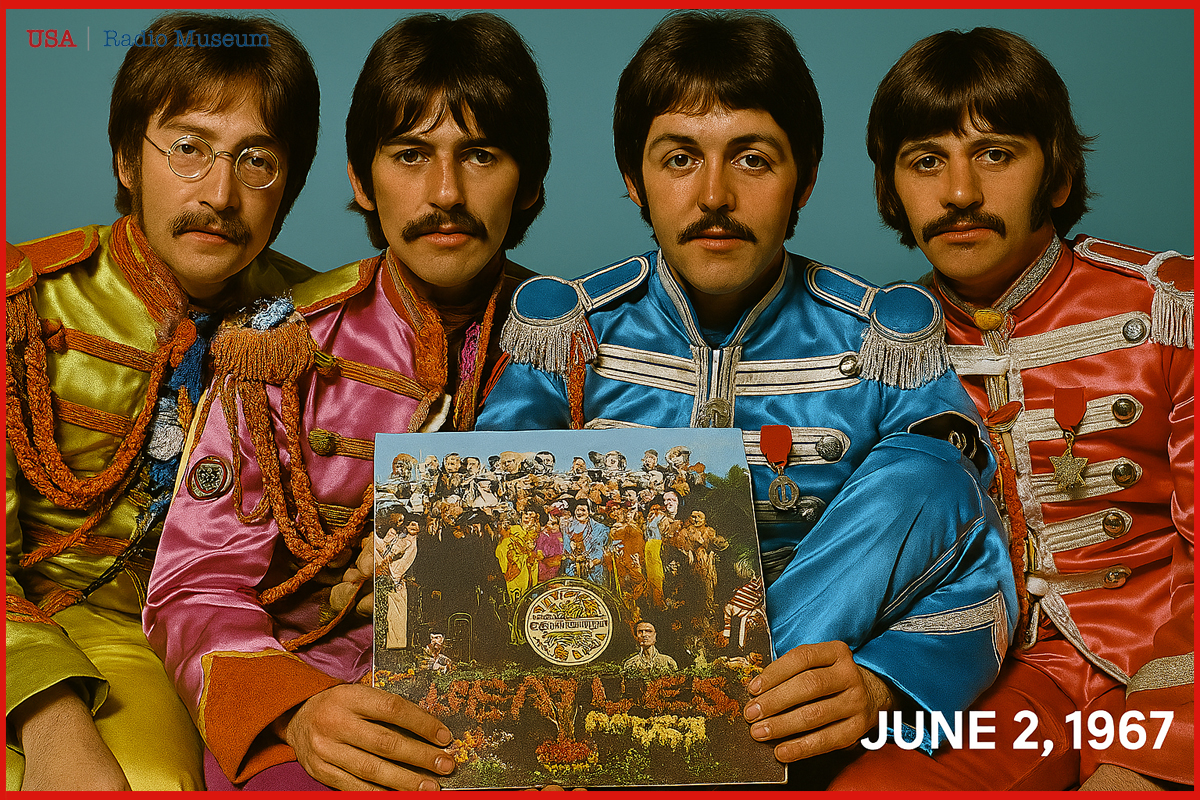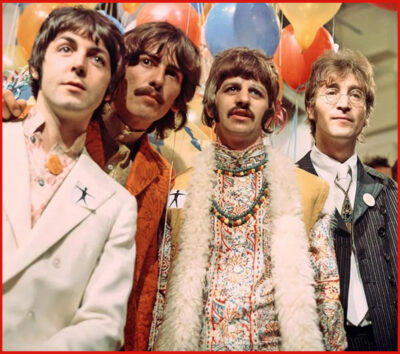Introduction: The Beatles’ Creative Breakthrough The Beatles had stopped touring in 1966, frustrated by the limitations of live perform
Introduction: The Beatles’ Creative Breakthrough
The Beatles had stopped touring in 1966, frustrated by the limitations of live performances and eager to push their creativity further. Freed from the constraints of the road, they spent months in the studio experimenting with new sounds, techniques, and ideas. The result? Sgt. Pepper’s Lonely Hearts Club Band, an album that blurred the lines between rock, pop, psychedelia, and avant-garde artistry.
Paul McCartney conceived the idea of a fictional band—Sgt. Pepper’s Lonely Hearts Club Band—that would serve as an alter ego for The Beatles. This concept allowed them to break free from their established image and explore new musical territories. The album was recorded between December 1966 and April 1967, with producer George Martin playing a crucial role in shaping its groundbreaking sound.
Recording Innovations & Studio Wizardry
The album was recorded at EMI Studios in London, with producer George Martin playing a crucial role in shaping its groundbreaking sound. The Beatles used multi-track recording, tape loops, and orchestral arrangements to create a rich, immersive listening experience.
Some of the most innovative techniques included:
- Artificial Double Tracking (ADT) – Used to enhance vocals and instruments.
- Varispeed Recording – Adjusting tape speed to alter pitch and tone.
- Tape Loops & Backward Recording – Heard in tracks like Being for the Benefit of Mr. Kite!.
The Songs That Defined an Era
Each track on Sgt. Pepper’s was meticulously crafted, showcasing The Beatles’ evolution as musicians and songwriters. Some of the most iconic songs include:
- “Lucy in the Sky with Diamonds” – A psychedelic masterpiece inspired by John Lennon’s son’s drawing, often associated with the counterculture movement.
- “A Day in the Life” – A haunting, orchestral epic that blends Lennon’s surreal lyrics with McCartney’s everyday observations.
- “With a Little Help from My Friends” – Sung by Ringo Starr, this song became an anthem of camaraderie and support.
- “Being for the Benefit of Mr. Kite!” – Inspired by a 19th-century circus poster, this track features swirling, carnival-like instrumentation.
The album’s title track and its reprise bookend the record, reinforcing the concept of a fictional band performing for an audience.
The Cultural Impact
When Sgt. Pepper’s hit the shelves, it wasn’t just another record—it was a statement. The Beatles abandoned the traditional pop formula, embracing psychedelic influences, orchestral arrangements, and avant-garde production techniques. The album reflected the spirit of the 1960s, a time of social change, artistic experimentation, and boundary-pushing creativity.
The album’s cover art, designed by Peter Blake and Jann Haworth, was just as revolutionary. Featuring a collage of famous figures—including Bob Dylan, Karl Marx, and Marilyn Monroe—it visually represented the eclectic influences that shaped the album.
The cover of Sgt. Pepper’s Lonely Hearts Club Band is one of the most iconic album designs in music history. Created by pop artists Peter Blake and Jann Haworth, the artwork was a visual representation of the eclectic influences that shaped the album.
The Concept Behind the Cover
Paul McCartney envisioned the album as a performance by a fictional band, and the cover was designed to reflect that idea. Blake suggested that The Beatles pose as if they had just played a concert in a park, with a crowd of fans behind them. However, instead of real fans, the background featured cutouts of famous figures, ranging from musicians and actors to writers and political thinkers.
How the Cover Came Together
The idea of featuring a collage of famous figures came from Paul McCartney, who wanted the album to feel like a performance by a fictional band. The Beatles worked closely with artist Peter Blake and Jann Haworth, who designed the cover based on lists provided by the band members.
- John Lennon suggested figures like Bob Dylan, Edgar Allan Poe, and Karl Marx. He even wanted Adolf Hitler and Jesus Christ, but EMI and the band decided to remove them due to controversy.
- Paul McCartney contributed names like Fred Astaire, Oscar Wilde, and Lewis Carroll, reflecting his admiration for literature and film.
- George Harrison focused on Indian spiritual leaders, including Sri Yukteswar Giri and Mahavatar Babaji, reflecting his growing interest in Eastern philosophy.
- Ringo Starr was more laid-back and reportedly said, “Whatever the others say is fine by me.”
EMI’s Involvement
EMI was initially concerned about legal issues regarding the use of celebrity images. Sir Joseph Lockwood, the head of EMI, insisted that the band get permission from each person featured on the cover. Most agreed, but Leo Gorcey, an American actor, demanded a fee, so his image was removed.
George Martin’s Role
While George Martin was instrumental in producing the album’s groundbreaking sound, he had little involvement in the cover design. His focus was on the music, but he later praised the artwork as a perfect visual representation of the album’s experimental nature.
Who’s on the Cover?
The collage includes over 50 images and wax figures of celebrities and historical figures. Some of the most recognizable faces include:
- Bob Dylan – A major influence on The Beatles’ songwriting.
- Karl Marx – Representing revolutionary ideas.
- Marilyn Monroe – A symbol of Hollywood glamour.
- Oscar Wilde – Celebrated for his wit and literary genius.
- Lewis Carroll – The author of Alice’s Adventures in Wonderland, a book that inspired psychedelic themes in music.
- Albert Einstein – A nod to intellectual brilliance.
- Shirley Temple – A beloved child star.
- Edgar Allan Poe – Known for his dark, poetic storytelling.
Interestingly, Adolf Hitler and Jesus Christ were originally included, but The Beatles decided to remove them due to their controversial nature.
The Wax Figures & Beatles’ Evolution
The cover also features wax figures of The Beatles themselves, dressed in their early 1960s suits. This was meant to symbolize their transformation—from clean-cut pop stars to experimental artists pushing musical boundaries.
The Bass Drum & Hidden Messages
The centerpiece of the cover is the Sgt. Pepper bass drum, designed by artist Joe Ephgrave. Fans have speculated that hidden messages exist within the artwork, including references to Paul McCartney’s rumored “death”—a conspiracy theory that emerged in the late 1960s.
The Gatefold Design – A First for Rock Albums
 Despite being a single album, Sgt. Pepper’s was released in a gatefold sleeve, a format usually reserved for double albums. This was a groundbreaking decision, emphasizing the album’s artistic significance.
Despite being a single album, Sgt. Pepper’s was released in a gatefold sleeve, a format usually reserved for double albums. This was a groundbreaking decision, emphasizing the album’s artistic significance.
Inside the gatefold, fans were treated to a striking photograph of The Beatles in their Sgt. Pepper uniforms, taken by Michael Cooper. The vibrant colors and elaborate costumes reinforced the album’s theatrical concept.
Additionally, the album included cut-out inserts, featuring:
- A Sgt. Pepper badge
- A mustache
- Stand-up figures of The Beatles
These extras made the album feel interactive, further immersing listeners in the world of Sgt. Pepper’s. The Sgt. Pepper’s cover was revolutionary because it broke away from traditional album artwork. Instead of featuring just the band, it created a visual collage of cultural icons, reflecting the album’s experimental nature. The design was so influential that it won a Grammy Award for Best Album Cover in 1968.
Critical Acclaim & Commercial Success
Sgt. Pepper’s Lonely Hearts Club Band was an instant success. It topped the Billboard 200 for 15 consecutive weeks, cementing its place as one of the greatest albums of all time. Critics praised its innovation, and it won four Grammy Awards, including Album of the Year.
Decades later, Sgt. Pepper’s remains a masterpiece. Rolling Stone magazine has consistently ranked it among the greatest albums ever, and its influence can still be heard in modern music.
How Radio Embraced Sgt. Pepper’s
Up until this point, radio stations—especially AM radio—were dominated by singles. Albums were often seen as secondary, with DJs focusing on hit songs rather than full-length records. But Sgt. Pepper’s changed that dynamic.
- FM radio stations embraced the album’s experimental nature, playing entire tracks rather than just singles.
- DJs on progressive rock stations treated Sgt. Pepper’s as a complete listening experience, encouraging audiences to hear it from start to finish.
- The album’s psychedelic themes resonated with the growing counterculture movement, making it a staple on underground radio.
This shift helped solidify the album format as a serious artistic medium, paving the way for future concept albums like Pink Floyd’s The Dark Side of the Moon and The Who’s Tommy.
Sales Figures: Then & Now
Upon its release, Sgt. Pepper’s Lonely Hearts Club Band was an instant commercial success. Here’s a look at its sales impact over time:
- 1967: The album sold over 2.5 million copies worldwide within its first year.
- 1970s: By the end of the decade, global sales had surpassed 7 million copies.
- 1987: The album was reissued for its 20th anniversary, leading to another surge in sales.
- 2017: For its 50th anniversary, a deluxe edition was released, pushing total sales past 32 million copies worldwide.
- 2025: As of today, Sgt. Pepper’s has sold over 35 million copies globally, making it one of the best-selling albums of all time.
A Record Legacy That Still Resonates
By June 1967, rock music was undergoing a radical transformation, and Sgt. Pepper’s Lonely Hearts Club Band arrived at the perfect moment to push the boundaries of what an album could be. The Beatles had already revolutionized pop music, but this LP was something entirely different—a concept album that blurred the lines between rock, art, and storytelling.
Almost six decades later, Sgt. Pepper’s Lonely Hearts Club Band remains a defining moment in music history. It revolutionized album production, inspired generations of musicians, and reshaped how audiences consumed music.
Its influence on radio, album culture, and artistic expression remains undeniable today, proving that The Beatles weren’t just making music—they were revolutionizing sound, reshaping creativity, and forever altering the course of modern pop/rock musical history.


